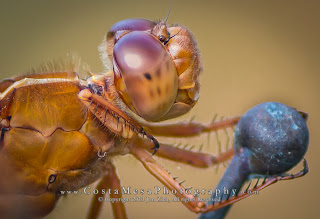 Over the past several months as I've been contemplating getting the new Nikon D7100 (to replace my D90), some people would ask me why? What features, what advantages, what new capabilities would be available?
Over the past several months as I've been contemplating getting the new Nikon D7100 (to replace my D90), some people would ask me why? What features, what advantages, what new capabilities would be available?There are many reasons why I wanted the upgrade...this posting is about just one of them--megapixels! The D90 had a 12.3 megapixel sensor, and the new D7100 has a 24.1 mexapixel sensor. While this has a variety of advantages, the specific one that I had in mind was the ability to maintain a quality, low-noise image on those occasions when I needed or wanted to do an extreme crop.
The desire to do an extreme crop sometimes occurs when I have an average image that would otherwise be on its way to the trash can, but it does have one redeeming value, and that's that I can see a "picture within the picture". This is a fancy way of saying that the original composure was poor, but in post processing a better composing is achievable. Another example of when an extreme crop is desirable, is when you've zooming in on a subject to the maximum capability of your equipment, but the end result isn't as close as you would like...this is when a further crop in post processing is necessary. And that was the case with this dragonfly picture.
I shot the image with my Tokina 100mm f/2.8 lens. I was approximately 18 inches away from the subject. The closest focusing distance of the lens is 12 inches so I want to give myself a little leeway to ensure I had a good lock on the dragonfly. I had my camera set to a relatively high shutter speed for this rather stationary subject, using 1/640 second. The camera was at an f-stop of 3.5 and ISO 220. In addition, I was in continuous focus mode with a single focus point. That's enough of the jargon for those who would be interested.
Once I got the image back onto my computer, I did the basic crop to get the more typical dragonfly picture one might see (which you can too on my website gallery at www.CostaMesaPhotography.com). I liked the image, but as I said, I wanted more of a close up. That's when the advantage of 24.1 megapixels comes into play. With a lesser quality image, if you crop is super tight you will have a "blurry" image because of pixilation...there won't be enough pixels to render a high-enough resolution image. But in my case, I had pixels to spare. You can almost think of it this way--if I cropped away half of my 24 megapixel image away, I'd have 12 megapixels left...the same amount as my old Nikon D90. But as you can see, I was able to crop in even tighter than that and still retain a laser-sharp, low-noise (grain) image. I've included a screen shot from Lightroom so you can see the extent of the crop.
If you have any questions or want to send me your comments, I'd always love to hear from you... CostaMesaPhotography@gmail.com
Jon
No comments:
Post a Comment